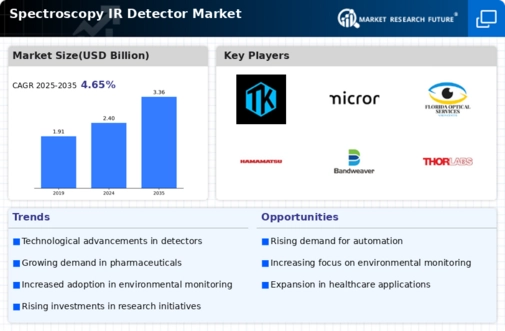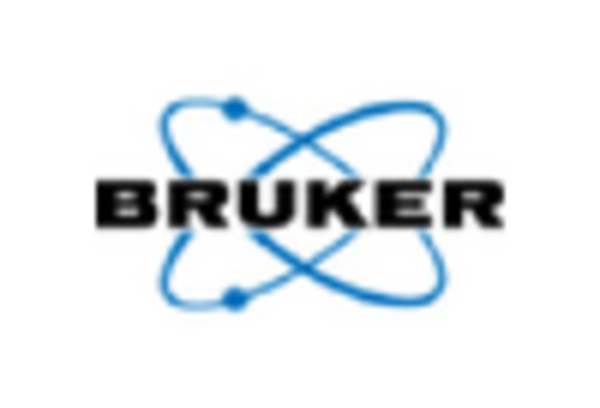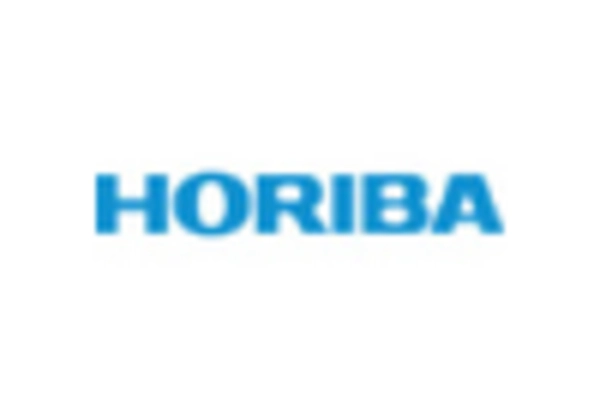Expansion of Industrial Applications
The expansion of industrial applications for spectroscopy is a significant driver of the Spectroscopy IR Detector Market. Industries such as petrochemicals, materials science, and manufacturing are increasingly adopting spectroscopic techniques for process monitoring and quality assurance. The ability of IR detectors to provide real-time analysis and feedback is enhancing operational efficiency and product quality. As industries seek to optimize their processes and reduce costs, the adoption of spectroscopy is likely to increase. This trend suggests a promising outlook for the Spectroscopy IR Detector Market, as more sectors recognize the value of these analytical tools.
Rising Demand for Analytical Instruments
The increasing need for precise analytical instruments is a primary driver of the Spectroscopy IR Detector Market. Industries such as pharmaceuticals, food and beverage, and environmental monitoring are increasingly relying on spectroscopy for quality control and compliance with regulatory standards. The market for analytical instruments is projected to grow at a compound annual growth rate (CAGR) of approximately 6.5% over the next five years, indicating a robust demand for IR detectors. This growth is fueled by the necessity for accurate and reliable data in research and development, which is essential for innovation and maintaining competitive advantage. As industries continue to prioritize quality and safety, the Spectroscopy IR Detector Market is likely to experience sustained growth.
Increased Focus on Research and Development
The emphasis on research and development across various sectors is propelling the Spectroscopy IR Detector Market. Academic institutions and research organizations are investing heavily in advanced spectroscopy techniques to enhance their analytical capabilities. This trend is reflected in the rising number of publications and patents related to spectroscopy, suggesting a vibrant research landscape. Furthermore, government funding for scientific research is expected to increase, providing additional resources for the development of new spectroscopy applications. As a result, the demand for sophisticated IR detectors is anticipated to rise, supporting the growth trajectory of the Spectroscopy IR Detector Market.
Growing Environmental Monitoring Initiatives
The rising awareness of environmental issues is driving the Spectroscopy IR Detector Market, particularly in the context of monitoring air and water quality. Governments and organizations are increasingly implementing regulations to ensure environmental safety, necessitating the use of advanced analytical techniques for compliance. Spectroscopy, with its ability to detect and quantify pollutants, is becoming a preferred method for environmental analysis. The market for environmental monitoring instruments is projected to grow, with spectroscopy playing a crucial role in this expansion. As environmental concerns continue to escalate, the demand for IR detectors in the Spectroscopy IR Detector Market is expected to rise.
Integration of Automation and AI Technologies
The integration of automation and artificial intelligence technologies into spectroscopy is transforming the Spectroscopy IR Detector Market. Automated systems enhance the efficiency and accuracy of spectroscopic analyses, reducing human error and increasing throughput. AI algorithms are being employed to analyze complex spectral data, enabling faster and more reliable results. This technological evolution is likely to attract investments in spectroscopy equipment, as companies seek to optimize their operations. The market for automated spectroscopy solutions is expected to expand significantly, further driving the demand for advanced IR detectors. Consequently, the Spectroscopy IR Detector Market stands to benefit from these innovations.

















Leave a Comment